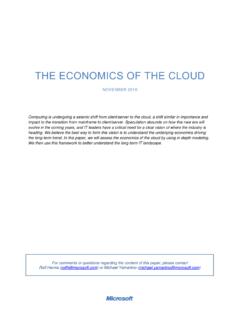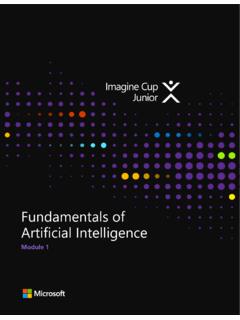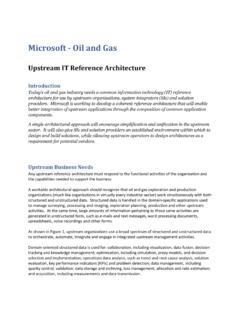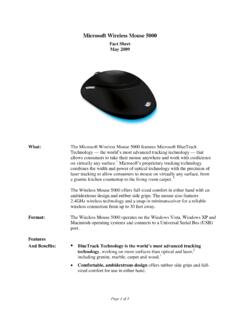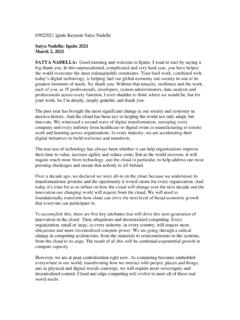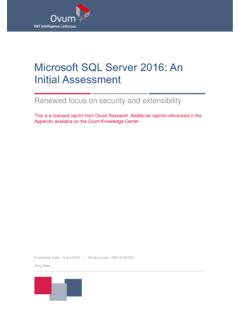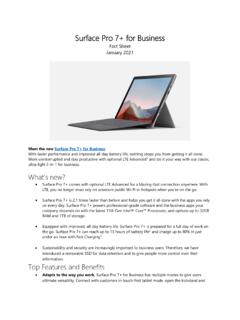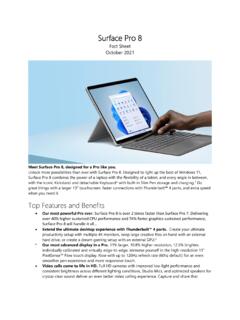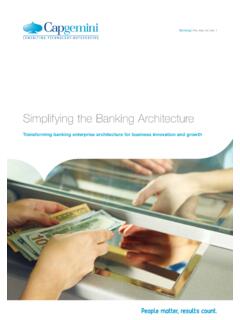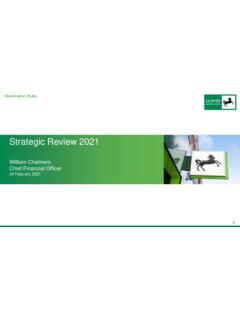Transcription of Microsoft Industry Reference Architecture for Banking …
1 Microsoft Industry Reference Architecture for Banking (MIRA-B) May 2012 Microsoft Corporation Microsoft Industry Reference Architecture for Banking Worldwide Financial Services Page 2 The intended audience of this document includes financial institution CTOs, technical and business architects, consultants, financial services technology vendors and others who are involved in making technology decisions within the Banking Industry . It assumes the reader is familiar with business and IT operations in the Banking Industry . For further information and updates related to MIRA-B, please visit Microsoft welcomes feedback and suggestions related to MIRA-B. Please email us at Microsoft Industry Reference Architecture for Banking Worldwide Financial Services Page 3 Contents Foreword .. 4 Introduction and Executive Summary.
2 5 Traditional Silos vs. Shared Service integration Approach .. 6 Microsoft Capabilities and Solutions in the Financial Services Industry .. 6 Microsoft Industry Reference Architecture for Banking (MIRA-B) .. 7 MIRA-B Business View .. 8 Alignment of Business View to Solutions and Capabilities .. 10 technology Forces Driving Architecture .. 12 Framework for Banking Solutions .. 15 Example scenarios .. 17 MIRA-B and Microsoft Platform Capabilities .. 22 technology Capabilities View of Microsoft Enterprise Platform .. 22 End User Experience .. 23 Application Services .. 25 Data Services .. 28 Infrastructure Services .. 30 Lifecycle Management .. 33 technology Capabilities View Microsoft Azure Platform .. 34 New Paradigms for Delivering Banking Applications .. 36 Industry Standardization of Banking Services .. 36 Extending Application Architectures to the Cloud .. 38 MIRA-B Developing a Services View of Architecture .
3 39 Microsoft Capabilities as an Enabler of Industry -standard Banking Services .. 43 Why Microsoft ? .. 46 Summary .. 47 Appendix A Big 49 Appendix B Innovative End User Experience .. 50 Appendix C Detailed Capability View .. 54 Appendix D Approach to Mission Critical Architectures .. 56 Appendix E Integrated Security Services .. 58 Appendix F Rapid Provisioning with Cloud Computing .. 60 Appendix G BIAN Service Landscape .. 61 Microsoft Industry Reference Architecture for Banking Worldwide Financial Services Page 4 Section I Foreword Yoshio Taniguchi, the famous Japanese architect who redesigned the Museum of Modern Art in New York, was quoted as saying: Architecture is basically a container of something. I hope they will enjoy not so much the teacup, but the tea. 1 Microsoft and its technology partners provide horizontal computing solutions and vertical Industry applications to major financial services institutions around the world.
4 As our worldwide financial services team at Microsoft engages customers, partners, and Industry analysts around the world we have derived a simple vision. That is: looking forward, financial institutions must be present in the financial lives of their customers any time, any place, on any device, and across any channel, and deliver value-added services in real-time. I want to thank our valued customers, partners and analysts who we are privileged to serve on a daily basis. With your continued support we will together redefine the value being realized in the Industry as we innovate together in financial services. The by-product of sound Architecture is a seamless customer experience. As a result of our Banking Architecture work, I hope that our Banking customers as well as their customers enjoy not so much the teacup, but the tea! Joseph Pagano Managing Director, Worldwide Banking & Capital Markets Microsoft Corporation Supporting organisations The following firms have provided endorsement for the MIRA-B framework: 1 Time magazine, 22 Nov 2004 Microsoft Industry Reference Architecture for Banking Worldwide Financial Services Page 5 Section II Introduction and Executive Summary The Banking Industry is experiencing unprecedented change with some even questioning whether it is possible for financial institutions to effectively serve customers, meet new regulatory requirements, and create innovative new business models and solutions while sustaining profitability.
5 Financial institutions are facing competition from non-traditional players; for example, global retailers providing in-store Banking services, phone companies providing mobile financial services, P2P payments firms taking increasing share of the lucrative payments market, P2P online lending firms becoming more popular, and personal financial management firms offering aggregation solutions that sit between the customer and the financial institution. Such disintermediation puts the financial institution further away from managing the customer experience across channels. It is safe to say that with increasing Tier 1 capital requirements, declining margins, and increasing operational costs, economics of the Banking business must change. Research from Temenos has shown that Banking has the highest IT cost as a percentage of total costs. This research estimates that 14% of costs in Banking are IT related compared to a cross Industry average of 7% caused by multiple factors including redundant, outdated, and/or siloed In response, Microsoft sees a number of financial institutions deploying shared resource models, removing silos and consolidating business processes, applications, and data to help bring costs more in line and dramatically impact the cost income ratio.
6 This is a major rationale for the creation of the Banking Industry Architecture Network (BIAN) which Microsoft co-founded in 2008 along with banks such as ING and Credit Suisse. BIAN is focused on creating an Industry -standard by defining common business services for Banking to simplify integration and reduce technology costs. Although increasing operational efficiency is a good business practice, it only buys time. Innovation which creates differentiated customer experiences at scale must be an equal partner on the agenda. Reference architectures are an important tool that can help financial institutions modularize and align business and technology assets in a predictable way. By developing business Reference architectures, financial institutions are in a position to start rationalizing and assigning role ownership to various Banking services which can then be consumed by other areas of the financial institution as needed.
7 Such repeatability and modularity removes redundancy and as a result lowers costs and speeds up the flow of information. It can also result in faster delivery of products to market, reduce operational risk, and improve the ability to listen to customers. Rapid deployments for example, of multi-channel customer facing solutions can help capture new customers and perhaps entire new markets as they emerge. Repeatable architectures allow financial institutions to differentiate their products and services and reuse commodity resources where efficiencies can be gained. Within the context of a common architectural framework this provides new levels of data, application, and business process transparency. Such transparency significantly improves a financial institution s ability to manage risk and understand the needs and wants of its customers. 2 Source: Tackling the Productivity Paradox (Temenos White Paper) Microsoft Industry Reference Architecture for Banking Worldwide Financial Services Page 6 Traditional Silos vs.
8 Shared Service integration Approach Application, data, and process silos still exist in many banks. This increases the number of moving parts, results in inconsistent customer experiences, and increases operational risk as well as operational costs. Figure 1: Traditional Silo vs. Shared Service integration An integrated platform aligned to a holistic Architecture view can help break down process, application, and data silos across the bank by fostering a shared services and resource capability. The result can drive cross divisional insights and upsell capabilities, reduce cost and risks, and improve customer satisfaction. Microsoft Capabilities and Solutions in the Financial Services Industry Microsoft is uniquely positioned to help financial institutions address Industry challenges and opportunities by providing a comprehensive array of mission-critical IT solutions and capabilities which span from the back-office to the front-office, device to the datacenter, on-premise, and in the cloud.
9 Microsoft s technologies are built for mission critical operations and are successfully deployed throughout many of the world s largest financial institutions. These capabilities include highly scalable server and client infrastructure, secure data and application platforms, Big Data and predictive customer analytics, ultra-low latency OS-level support, productivity, CRM/xRM, workflow and collaboration, as well as the connected user experience both on premise and in the cloud. Such capabilities are the foundation for Microsoft and its extensive ecosystem of Industry partners in the areas of Sales & Service, Digital Marketing, Governance, Risk, & Compliance, Business Insights and Operations. Microsoft Industry Reference Architecture for Banking Worldwide Financial Services Page 7 Figure 2: Alignment of Microsoft Platform to Partner Solutions Microsoft Industry Reference Architecture for Banking (MIRA-B) The Microsoft Industry Reference Architecture for Banking (MIRA-B) depicts a Banking Architecture based-on Microsoft s technology platform and services.
10 MIRA-B provides a logical architectural point of view for financial institutions to use for planning purposes. This begins with a business Architecture view (aligned to the work of BIAN) of the vertical lines of the Banking business and aligns those to a logical Banking technology Architecture leveraging platform and infrastructure services for on-premise and cloud deployments of Banking application services. Figure 3: MIRA-B Document Flow Beyond the elements of the MIRA-B Reference Architecture , Microsoft also recognizes that mission critical solution deployments in financial services require much more than just technical capability. Microsoft advocates that the appropriate process, people and governance around financial services solutions is also vital. This topic is explored in more detail in Appendix D Approach to Mission Critical Architectures Microsoft Industry Reference Architecture for Banking Worldwide Financial Services Page 8 Section III MIRA-B Business View This section of the Architecture presents a technology agnostic, business view of Banking operations.
